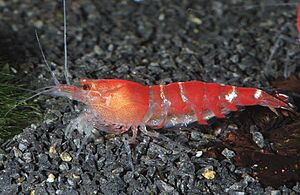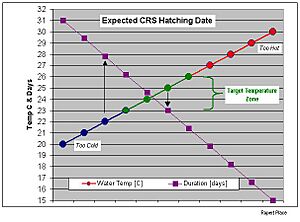Bee shrimp facts for kids
Quick facts for kids Bee shrimp |
|
|---|---|
 |
|
| Conservation status | |
| Scientific classification | |
| Genus: |
Caridina
|
| Species: |
cantonensis
|
The bee shrimp (Caridina cantonensis) is a small, freshwater shrimp. It belongs to the Atyidae family. These tiny creatures come from Taiwan.
Bee shrimp are natural scavengers. They help keep their environment clean by eating small bits of dead plants and algae. These shrimp usually live for about 18 months. They like water temperatures between 21 and 26 degrees Celsius (70 to 78 degrees Fahrenheit). Many of the bee shrimp you see today have been specially bred to have unique colors and patterns.
People love to keep bee shrimp as pets in aquariums. Because they are so popular, shrimp farms have started in places like Taiwan. These farms help supply bee shrimp to pet stores. However, bee shrimp are a bit tricky to raise. They need soft water with a specific pH level, just like the streams where they naturally live.
Contents
Cool Kinds of Bee Shrimp
There are many different types of bee shrimp. Each one has its own special look!
Black Bee Shrimp: The Original
The black bee shrimp is the most common type. It's sometimes called the Crystal Bee. Many other colorful types of bee shrimp were created from the black bee shrimp through careful breeding.
Blue Bee Shrimp: From the Wild
Blue bee shrimp are found in the wild. They are collected from streams in China. Aquarium owners really like these blue shrimp for their tanks.
Golden Bee Shrimp: A Shimmering Look
The golden bee shrimp has a white shell. Its body underneath has a pretty orangey-gold color.
Crystal Red Shrimp: A Hobby Favorite
The crystal red shrimp is also known as the "red bee shrimp" in Japan. This type has bright red and white stripes. It was specially bred for people who love aquarium hobbies.
In 1996, a man named Hisayasu Suzuki in Japan found a red shrimp among his black bee shrimp. Later, he found two more. By carefully breeding these red shrimp, he and other breeders created shrimp with very strong red and white patterns.
Other Fun Bee Shrimp Names
Shrimp breeders have given many other creative names to different bee shrimp types. Some of these include the Princess Bee, Blue Bolt, Tangerine Tiger, and Shadow Panda.
How Bee Shrimp Have Babies
It's easy to tell the difference between male and female bee shrimp. Female shrimp are usually bigger than males. They also have a deeper, rounder belly.
When a female shrimp is ready to mate, she releases special scents into the water. These scents, called pheromones, tell the male shrimp where to find her. The male shrimp will then swim around very actively to find the female.
After mating, the female carries her eggs under her belly. She uses her tiny legs, called pleopods, to keep water flowing over the eggs. This helps the eggs stay healthy. When the eggs hatch, tiny versions of the adult shrimp appear!
The time it takes for the eggs to hatch depends on the water temperature. If the water is about 22 degrees Celsius (72 degrees Fahrenheit), the eggs will hatch in about 28 days. Shrimp often develop their brightest colors when the water is between 24 and 25 degrees Celsius (75 to 77 degrees Fahrenheit).
It's important to keep the water temperature just right. If the water stays too warm for too long, more young and adult shrimp might die. Also, fewer eggs might survive. Warmer water can make shrimp grow up faster, but they might be smaller. Colder water slows down their growth, giving them more time to grow bigger before they are ready to have babies.
Images for kids








